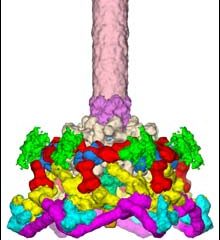Articles and reports from the Life Sciences and chemistry area deal with applied and basic research into modern biology, chemistry and human medicine.
Valuable information can be found on a range of life sciences fields including bacteriology, biochemistry, bionics, bioinformatics, biophysics, biotechnology, genetics, geobotany, human biology, marine biology, microbiology, molecular biology, cellular biology, zoology, bioinorganic chemistry, microchemistry and environmental chemistry.

The complete genome sequence of a leading bacterial plant pathogen offers new ways to stave off agricultural loss and perhaps foil animal or human infection, says a Cornell University researcher.
According to Alan Collmer, Cornell professor of plant pathology, the sequencing (that is, determining the base sequence of each of the ordered DNA fragments in the genome) could help farmers repress tomato speck and other plant diseases. Medical researchers could be aided in comparing a related b

Imagine a virus and its cellular target as two spacecraft – the virus sporting a tiny docking bay that allows it to invade its victim. Purdue University researchers have taken a close-up picture of one virus’ docking bay, work that could have implications for both medicine and nanotechnology.
Using advanced imaging techniques, an international team of biologists led by Michael Rossmann of Purdue, Vadim Mesyanzhinov in Moscow and Fumio Arisaka at the Tokyo Institute of Technology has an

Findings similar to results with embryonic and neural stem cells
University of Minnesota researchers show that adult bone marrow stem cells can be induced to differentiate into cells of the midbrain. The findings, published in the online early edition of the Proceedings of the National Academy of Sciences, suggest that adult bone-marrow-derived stem cells may one day be useful for treating diseases of the central nervous system, including Parkinson’s disease.
The potent

There has been some controversy in the media and within the scientific research community concerning whether Icelanders are genetically homogenous or heterogeneous relative to other European populations.
Following an article published in Annals of Human Genetics in January 2003 by E. Árnason, who concluded that Icelanders were one of the most heterogeneous populations in Europe, researchers from deCODE Genetics and the University of Oxford, have published an article in Annals of Human Geneti

The cell-surface associated molecule Cripto is overexpressed in a wide range of epithelial cancers, yet little is known about the potential mechanisms by which Cripto expression might enhance tumor growth. A new study by Michele Sanicola and colleagues at Biogen Inc. in the August 15 issue of the Journal of Clinical Investigation reveals that binding of Cripto to the TGFbeta ligand Activin B can block Activin B-mediated suppression of cell proliferation. Furthermore, this study also demonstrates that

It may be small, its habitat harsh, but a newly discovered single-celled microbe leads the hottest existence known to science. Its discoverers have preliminarily named the roughly micronwide speck “Strain 121” for the top temperature at which it survives: 121 degrees Celsius, or about 250 degrees Fahrenheit. Announcing Strain 121’s record-breaking ability to take the heat in the August 15 issue of the journal Science, researchers Derek Lovley and Kazem Kashefi write, “The upper